La maggior parte delle murature ora visibili fanno parte del santuario romano: in colore è segnato quanto rimane dei muri di terrazzamento costruiti durante la seconda età del Ferro, in particolare fra il III e il I secolo a.C.
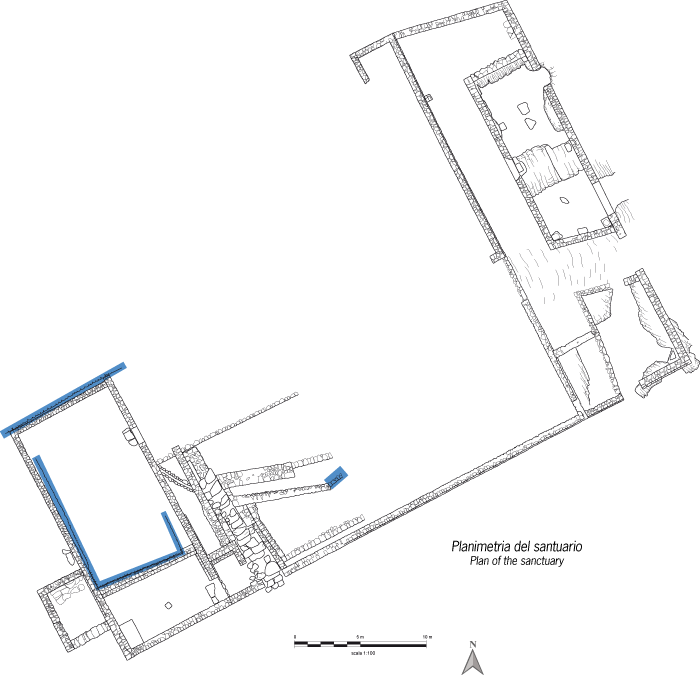
In questo periodo Monte San Martino è frequentato da una popolazione legata alla Cultura di Fritzens-Sanzeno (i Reti), che interagisce fortemente con l’ambito culturale della vicina Valcamonica, come accade in generale per le valli Giudicarie e per le zone prospicienti il Garda occidentale.
Il sito viene scelto come luogo di culto in cui si celebrano riti all’aperto che prevedono l’accensione di grandi roghi votivi (Brandopferplätze), il sacrificio di animali, l’offerta di prodotti dalla terra e di oggetti in metallo e in ceramica: queste pratiche sono diffuse in tutta l’area alpina centro orientale perlomeno a partire dal XIV secolo a.C. e proseguono in alcuni casi fino all’età romana. A Monte San Martino, vicino ai muri di terrazzamento, sono stati messi in luce consistenti depositi carboniosi che contenevano tazze e boccali frantumati intenzionalmente, nonché un pettine in osso; i reperti recano molto spesso segni incisi e brevi iscrizioni in alfabeto preromano.
Dagli stessi strati carboniosi provengono anche piccoli oggetti in lamina di bronzo e una chiave.
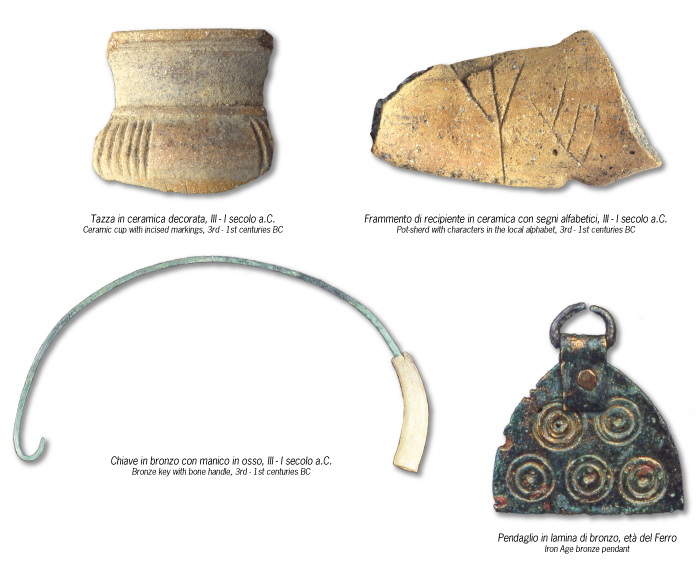
Anche se rimane sconosciuto il nome delle divinità, se ne può individuare l’ambito considerando i diversi oggetti facenti parte delle offerte, che rimandano da un lato alla natura e al mondo agreste e dall’altro alla fecondità e ai riti di passaggio di nascita, vita e morte.
Le chiavi, ad esempio, usate per chiudere o aprire spazi contenenti beni materiali, assumono in antico un alto significato simbolico legato proprio ai misteri del ciclo vita-morte, attraverso il potere di governare l’apertura e la chiusura di questo delicato passaggio.
Le chiavi, ad esempio, usate per chiudere o aprire spazi contenenti beni materiali, assumono in antico un alto significato simbolico legato proprio al potere di accesso a questi spazi importanti e, per estensione, al potere di governare i delicati passaggi nel misterioso ciclo vita-morte.
THE PRE-ROMAN RELIGIOUS SITE
Most of the walls which can now be seen belong to the Roman sanctuary: the coloured section marks the remains of terrace walls constructed during the second Iron Age, particularly between the 3rd and 1st century BC
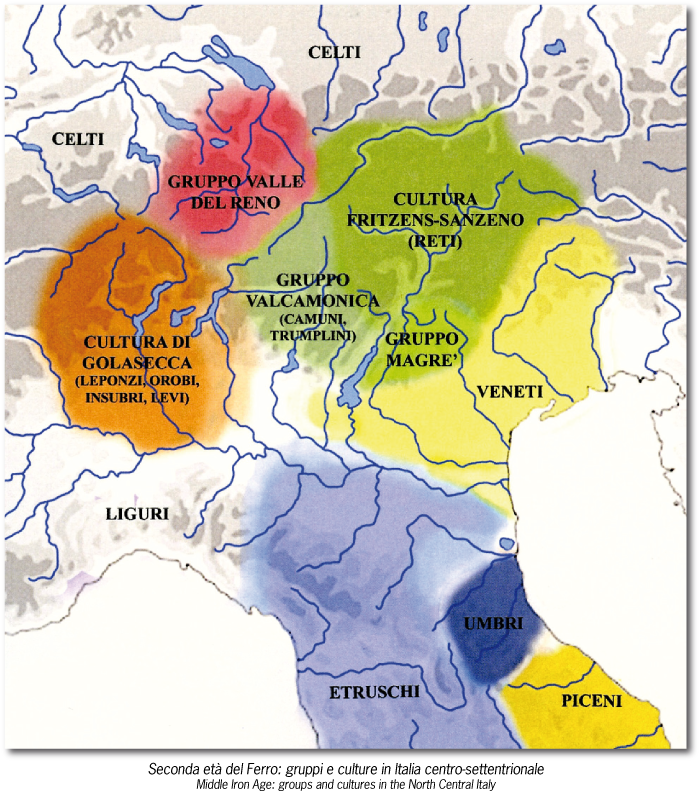
In this period Monte San Martino was frequented by a population linked to the Fritzens-Sanzeno Culture (the Rhaetians), which had close links with the cultural environment of the nearby Valcamonica, as generally took place in the Giudicarie valleys and the areas overlooking the western side of Lake Garda.
The site was chosen as a place of worship for open-air rites, such as celebrations providing for the lighting of large votive fires (Brandopferplätze), the sacrificing of animals and the offering of products of the land and metal and pottery objects. These practices were widespread throughout the whole central-eastern Alps starting from the 14th century BC at least, and in some cases continued up to the Roman era. At Monte San Martino carbonaceous deposits containing fragments of deliberately shattered bowls and jugs, along with a bone comb, have been brought to light near the walls of the terraces. The findings often have engraved marks and brief inscriptions in the pre-Roman alphabet.
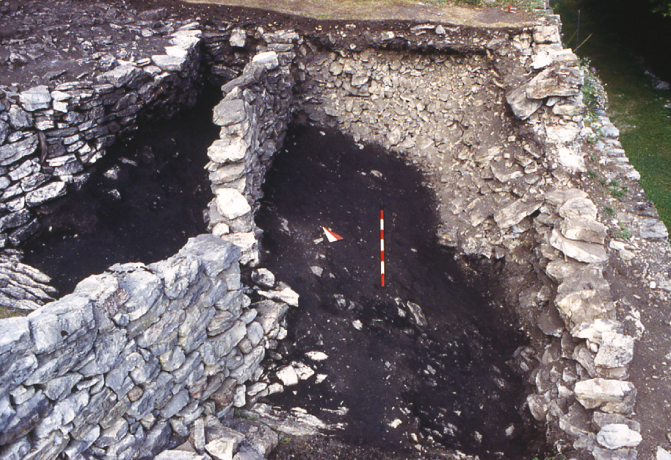
muri di terrazzamento e terra di rogo – Terrace walls and carbonised deposits
Some small objects in bronze sheet and a key were also found in the same carbonaceous layers.
Although the name of the divinity worshipped is unknown, it is possible to identify the context by considering the different offerings, on the one hand linked to nature and the agricultural world and on the other to fertility and rites of passage connected to birth, life and death.
In ancient times, for example, as keys were used to open and close spaces containing material assets, they had an important symbolic meaning, linked specifically to the power to access these areas and, following on from this, to control of the delicate passages in the mysterious cycle of life and death.
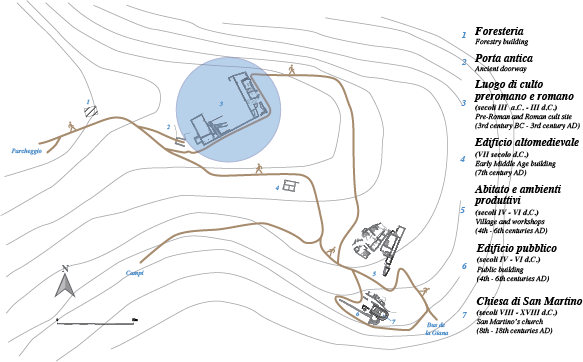
Die vorrömische Kultstätte
Der Großteil des heute sichtbaren Mauerwerks gehört zu dem römischen Heiligtum: Farbig sind die Überreste der Terrassierungsmauern aus der späten Eisenzeit (insbesondere 3. – 1. Jh. v. Chr.) gekennzeichnet.
In dieser Zeit suchen Menschen aus der Fritzens-Sanzeno-Kultur (Räter) den Monte San Martino auf, die rege Kontakte zu dem Kulturkreis des nahe gelegenen Valcamonica pflegen, wie es allgemein in den Tälern der Judikarien und den Gebieten westlich des Gardasees der Fall war. Der Monte San Martino wird als Kultstätte bzw. Brandopferplatz gewählt, für rituelle Handlungen unter freiem Himmel, bei denen große Scheiterhaufen angezündet, Tiere geopfert, Früchte sowie Metall- und Keramikgegenstände dargebracht werden. Derartige Kulthandlungen sind im gesamten Zentral- und Ostalpenraum spätestens seit dem 14. Jh. v. Chr. verbreitet und werden in einigen Fällen bis zur Römerzeit fortgesetzt.
Auf dem Monte San Martino wurden nahe der Terrassierungsmauern große kohlenstoffhaltige Ablagerungen gefunden, die absichtlich zerschlagene Schalen und Krüge sowie einen Knochenkamm enthielten; die Fundstücke tragen sehr oft eingeritzte Zeichen und kurze Inschriften in einem vorrömischen Alphabet. Aus denselben kohlenstoffhaltigen Schichten stammen auch kleine Gegenstände aus Bronzeblech und ein Schlüssel. Auch wenn der Name der hier verehrten Gottheit weiterhin unbekannt ist, lässt sie sich anhand der verschiedenen Opfergaben einordnen, die einerseits an Natur und Ackerbau, andererseits an die Fruchtbarkeit sowie an Geburt, Leben und Tod erinnern. Schlüssel, zum Beispiel, die Räume schließen oder öffnen können, die materielle Güter enthalten, haben in der Antike eine große symbolische Bedeutung. So ermächtigt ihr Besitz den Zugang zu solch wichtigen Räumen und verleiht, im übertragenen Sinn, die Kontrolle über die Passagen im geheimnisvollen Zyklus von Leben und Tod.